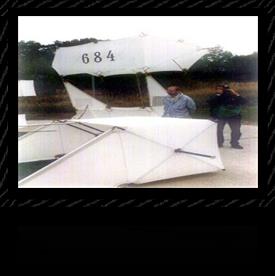
Copyright © 2005-2019 by Robert Moore · All Rights reserved · E-Mail:droceretik@gmail.com
High altitude kite flying history
I In the early part of the modern era of kite flying, that is 1880 to 1930, the majority of high altitude kite flying was conducted at weather stations in Europe and the United States.
After a break of nearly 40 years, recreational kites, including the delta became more readily available and cheaper and by 1965 there were dozens of plastic kite designs including the "bat kite" and other delta derivatives. These new light weight kites and the advent of synthetic materials enabled any child to afford a kite and some would let all their string out to soar their kites to 300 or 400 ft. above the ground and sometimes higher. There are always those amongst us who want to push the limits and are fascinated by reaching the boundaries of their physical world. In 1969, a team of Gary Indiana Wirt high school students, with support from the Gayla Kite Company, flew a train of 19 plastic delta kites on nylon fishing line. They claim over 35,000 ft. above ground level was reached and they maintain line out and a catenary equation were good enough to support their claim for record altitude. I doubt very much that they achieved this height however they had fun and they probably reach a decent altitude but there practice of not retrieving the line and releasing many miles of fishing line into the environment is unforgivable. Also not retrieving the kites and line by winding the line in constitutes a failed flight and would not be recognised by Guinness World Records today. In fact it has been removed from the Guinness archives for these reasons. The Lindenberg train flight of 1919 should also be struck from the records for the same reason, that is, the line broke and they did not retrieve the kites by winching the line in.
Above: Are the types of kites that were used in Germany for high altitude flights during routine atmospheric soundings in the first quarter of the 20th century. This is at Lindenberg, site of the absolute world altitude record set at 31,955 ft in 1919. The line broke on retrieval but luckily they recovered the instrument otherwise they had no evidence. Still a dubious claim IMO if they did not wind the kites in.
Richard Synergy of Toronto, Canada claimed he flew a 270 sq meter Delta to 14,509 ft above ground level on the 14th of August 2000 near Kincardine Canada. It was ratified by Guinness World Records and was the target for our world record attempts which we broke with a flight to 16,009 ft in 2014.
Image: Richard Synergy and Drachen foundation
A Gary Indiana High School math teacher performed the catenary calculations hat were used to submit the claimed altitude to The Guinness Book Of Records in 1969. Still flawed assumptions and no direct measurement of the kite's altitude.
image: Gayla Kite Company via Kitelife magazine
Images: Lindenberg Museum
Late in the 19th century, a US weather station box kite, a derivative of The Hargraves Box Kite. A meteorograph is between the cells, top centre and it measures and records barometric pressure then transfers to a rolling graph paper with ink pens. Trains of these kites regularly flew over 10,000 ft.
Image: Drachen Foundation
The Lindenberg weather station's kite round house showing control switches and line tension dynamometer the whole winch house rotated to face the wind's direction or line position.
Professor Ben Balsley (deceased) was part of the CIRES research team on Christmas Island which flew two parafoils in a train formation to 10,000 ft collecting atmospheric data. Circa 1998.
Richard Crawford flew this big delta to 0ver 6,500 ft in Colorado in 2006. His kite had a variable geometry angle of attach device but it proved fragile and broke. He was sponsored by Twinline.
One of the large Lindenberg weather station kites, a derivative of Hargrave's box kites. It is not clear how high one of the single kites flew but a train of 19 similar desigs of various sizes flew to 31,955 ft in 1919. They used "piano wire" and a steam generated electric winch.
William Eddy was an an American accountant who invented his version of the diamond kite and this was used for some high altitude flights and for weather observations about the same times the Hargrave box kites were invented. Reportedly reach over 8,000 ft carrying instruments and cameras for aerial photography.
The Blue Hill observatory flew versions of the Hargrave box kite to over 4,000 ft with single kites and 12,000 ft with trains of these kites. I believe they used "piano" wire which is 8 times heavier than the Dyneema line I used for the kite record flights. You can see a rotating winch house similar to the Lindenberg observatory.
French military or Conyne kites were invented for battle field observation during WW1. Interestingly the Conyne Delta and DT delta kites are a derivative of the Conyne. On the right can be seen a train of Conynes which were capable of high altitude but in thos days, line weight and thickness was a limiting factor. In these images are early aerial photographs.
I believe this is Englishman and meteorologist Archibold who flew the Eddy kites with instruments to capture atmosheric data. Most early high altitude kite flights were not made to break records but to capture weather data only. They were inadvertently breaking altitude records but they may have noted these milestones.
FOR ALL YOU KITE NEEDS VISIT http://www.kitesite.com.au/
Kite Altitude World Record

















